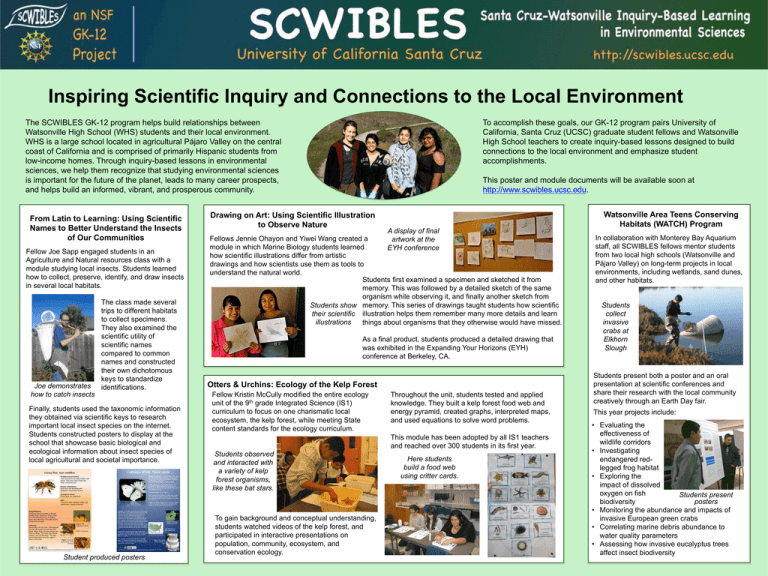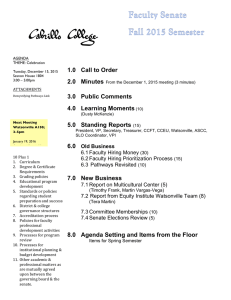To accomplish these goals, our GK-12 program pairs University of
advertisement

Inspiring Scientific Inquiry and Connections to the Local Environment The SCWIBLES GK-12 program helps build relationships between Watsonville High School (WHS) students and their local environment. WHS is a large school located in agricultural Pájaro Valley on the central coast of California and is comprised of primarily Hispanic students from low-income homes. Through inquiry-based lessons in environmental sciences, we help them recognize that studying environmental sciences is important for the future of the planet, leads to many career prospects, and helps build an informed, vibrant, and prosperous community. From Latin to Learning: Using Scientific Names to Better Understand the Insects of Our Communities Fellow Joe Sapp engaged students in an Agriculture and Natural resources class with a module studying local insects. Students learned how to collect, preserve, identify, and draw insects in several local habitats. Joe demonstrates how to catch insects The class made several trips to different habitats to collect specimens. They also examined the scientific utility of scientific names compared to common names and constructed their own dichotomous keys to standardize identifications. Finally, students used the taxonomic information they obtained via scientific keys to research important local insect species on the internet. Students constructed posters to display at the school that showcase basic biological and ecological information about insect species of local agricultural and societal importance. Student produced posters To accomplish these goals, our GK-12 program pairs University of California, Santa Cruz (UCSC) graduate student fellows and Watsonville High School teachers to create inquiry-based lessons designed to build connections to the local environment and emphasize student accomplishments. This poster and module documents will be available soon at http://www.scwibles.ucsc.edu. Drawing on Art: Using Scientific Illustration to Observe Nature A display of final artwork at the EYH conference Fellows Jennie Ohayon and Yiwei Wang created a module in which Marine Biology students learned how scientific illustrations differ from artistic drawings and how scientists use them as tools to understand the natural world. Students first examined a specimen and sketched it from memory. This was followed by a detailed sketch of the same organism while observing it, and finally another sketch from Students show memory. This series of drawings taught students how scientific their scientific illustration helps them remember many more details and learn illustrations things about organisms that they otherwise would have missed. As a final product, students produced a detailed drawing that was exhibited in the Expanding Your Horizons (EYH) conference at Berkeley, CA. Otters & Urchins: Ecology of the Kelp Forest Fellow Kristin McCully modified the entire ecology unit of the 9th grade Integrated Science (IS1) curriculum to focus on one charismatic local ecosystem, the kelp forest, while meeting State content standards for the ecology curriculum. Throughout the unit, students tested and applied knowledge. They built a kelp forest food web and energy pyramid, created graphs, interpreted maps, and used equations to solve word problems. This module has been adopted by all IS1 teachers and reached over 300 students in its first year. Students observed and interacted with a variety of kelp forest organisms, like these bat stars. To gain background and conceptual understanding, students watched videos of the kelp forest, and participated in interactive presentations on population, community, ecosystem, and conservation ecology. Here students build a food web using critter cards. Watsonville Area Teens Conserving Habitats (WATCH) Program In collaboration with Monterey Bay Aquarium staff, all SCWIBLES fellows mentor students from two local high schools (Watsonville and Pájaro Valley) on long-term projects in local environments, including wetlands, sand dunes, and other habitats. Students collect invasive crabs at Elkhorn Slough Students present both a poster and an oral presentation at scientific conferences and share their research with the local community creatively through an Earth Day fair. This year projects include: • Evaluating the effectiveness of wildlife corridors • Investigating endangered redlegged frog habitat • Exploring the impact of dissolved oxygen on fish Students present posters biodiversity • Monitoring the abundance and impacts of invasive European green crabs • Correlating marine debris abundance to water quality parameters • Assessing how invasive eucalyptus trees affect insect biodiversity


